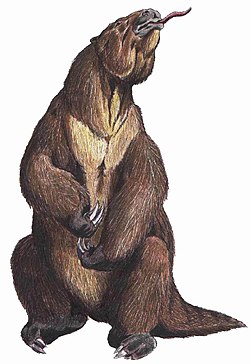Classification
Within the Megatheriidae there are two (possibly three) subfamilies; the Megatheriinae and the Planopsinae. The phylogenetically older group is represented by the Planopsinae from the Lower and Middle Miocene. These still possessed a caniniform anterior tooth, which was separated from the posterior molar-like teeth by a small diastema . The more derived Megatheriinae, which are known from the Middle Miocene to the Early Holocene, on the other hand, had fully homodontic molars in a closed row. [4] Originally, the subfamilies of the Nothrotheriinae and the Schismotheriinae were also placed in the Megatheriidae. [5] Based on skull studies, the Nothrotheriidae, in which, among other genera, Nothrotherium , Nothrotheriops, and the semiaquatic Thalassocnus are placed, are regarded as a separate family, which forms the sister group of the Megatheriidae. [6]
This page is based on this
Wikipedia article Text is available under the
CC BY-SA 4.0 license; additional terms may apply.
Images, videos and audio are available under their respective licenses.


